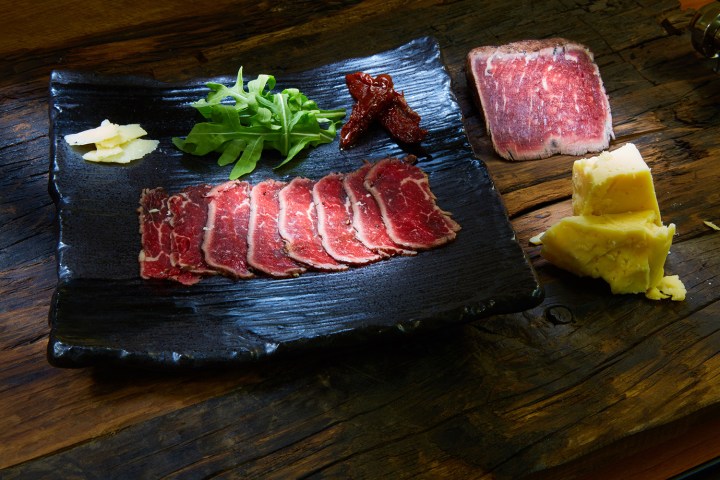
What is sous vide?

Sous vide, a French term meaning “under vacuum,” is a water-based cooking technique that can be used across a wide variety of foods. It doesn’t work too well for things like baking or sautéing, but when it comes to meat, seafood, eggs, vegetables, and other menu items, it can prove very effective.
Sous vide has grown more popular with the advance of smart kitchen tools that can accurately judge temperature and set automatic timers. Despite the presence of high-tech cooking, however, sous vide is actually a very simple concept. It involves two important steps:
- Sealing foods and their related ingredients in a plastic bag. Sometimes a canning jar or other receptacle is used, depending on the method.
- Placing the sealed food in water, often in a pot or specialized cooker, and cooking it there at a precise temperature for a certain amount of time.
Wait, so are we just boiling foods now instead of roasting them? Not exactly, since the food is safely sealed away from the water, it doesn’t boil (unless you want it to), and the temperatures are often lower than the boiling point of 212 degrees Fahrenheit (100 degrees Celsius). It simply cooks in a very uniform way, and there are several advantages to this type of cooking that food fans and ambitious chefs greatly appreciate.
Why is sous vide is so popular?

Chefs like the sous vide method because it removes a lot of the problems with cooking demanding foods over traditional sources of heat. You see, heat via a burner — gas, electric, charcoal, what have you — is never uniform. While the infrared energy that comes from a burner steadily increases the heat of air and objects around it, it’s impossible to fully predict or control, and you can’t hold it at a specific temperature for long periods of time (no matter what your oven tells you). This is why it’s so difficult to cook the perfect steak or fish, even with years of practice. The heat is uneven, constantly changing, and cannot be left on without burning the food. The window for an ideal cooked meat may be only a minute or less.
Sous vide, on the other hand, removes most of these difficulties. When meats and other foods are cooked in water, they are heated precisely from all sides with a temperature that can be easily controlled and maintained at exact levels of heat for precise periods of time. No exposure to flame or external air means no charring or drying out, either. As a result, all the meat and other ingredients are cooked equally well, all the way through. Since temperatures are controlled so precisely, you don’t need to rush off to the kitchen or hover over the stove, either. Also, because the process is so reliable, it allows people with less experience in the kitchen to tackle more difficult meals with greater confidence — and save more time.
There are other, less tangible benefits too. Sous vide is supposed to help lock in natural juices more effectively, increase the amount of edible meat you get on a cut, and may even increase nutritional value.
More sous vide info below:
The downsides of sous vide

Sous vide may be great for many types of cooking, but it has its caveats. Some things will be too large to submerge in water — you probably couldn’t sous vide a turkey at home, for instance. You also have to pick recipes that allow you to seal the important ingredients in a plastic pouch or container, which isn’t always feasible, and heating plastic makes some people nervous. It does tend to work very well with marinades, though.
Additionally, for the average home cook, sous vide typically requires an investment in new technology, including important sensors and devices that help maintain water temperature. It’s rarely a cost-free enterprise. Also, vegetables need to cook at a much higher temperature than meat, so you probably can’t make your whole meal at once. If you’re making steak with the sous vide method, you’ll still want to throw it in a pan, on the grill, or under a blowtorch to get a nice sear.
Sous vide technology

Sous vide wasn’t really accessible to home chefs a decade ago, but today’s smarter kitchens are better suited for this type of cooking thanks to devices like the ones outlined below.
Whole sous vide units: These are units that combine all aspects of the sous vide process into one rather large countertop appliance. A good example would be Mellow, which costs $600. A number of these sous vide products and “water ovens” have popped up on crowdfunding sites, too. These ovens offer flexible temperature control, accompanying recipes, and, of course, size advantages.
Vacuum sealers: Vacuum sealers are not technically required for sous vide cooking, although they are very handy. After all, you don’t want to trust a Ziploc bag for these kinds of projects, and bags made for cooking are safe when it comes to chemicals. You can buy both sous vide-centric pouches and sealers, though the cost-conscious consumer might prefer the $20 handheld zip sealer as an alternative.
Temperature readers: If you plan on doing some sous vide away from a water oven or other cooker, you’ll need to use more traditional means… and you’ll need a way of measuring water temperature. There are many digital thermometers out there, but you’ll want one that is specifically designed to measure water temperature, like the Dorkfood Sous-Vide Temperature Controller.
Immersion circulators: These are somewhere between the whole units and the temperature readers. They both regulate the temperature and circulate the water to keep it more precise. Anova, Sansaire, Joule, and Nomiku all make $200 devices that clip onto your pot and let you sous vide on your counter.
Sous vide tips and tricks

Utilizing the sous vide method isn’t incredibly hard to do, but mastering it can be tough. Thankfully, we have a few suggestions on how to do so the right way.
- Put it in a pan — You may be wondering about the elephant in this water-filled room. For many meat dishes its very important to sear, smoke, or otherwise burn the meat at least a little for flavor, texture, and appearance. You can easily slide meat over to a pan for a bit of searing when it’s done cooking in the water.
- Season less, not more — It may be tempting to season your food even more when using sous vide, but this method of cooking is actually very good at locking in flavor. You’ll probably want to season a bit less than usual.
- Don’t be afraid to lower the temp (and increase the timer) — You can cook things like poultry without worrying about hitting a high temperature to kill bacteria. For example, you can cook chicken at 140 degrees Fahrenheit for an extended period of time to get more succulent chicken that’s still perfectly safe.
- Use a holding pattern — As long as you hold the temperature at an ideal place, you can keep food in the water without worrying about it overcooking. Use this if a dinner party runs late (and they always do).
- Be patient — With this method of cooking, you can’t turn on the oven light, poke a knife in the center, or anything else. Your best bet is to trust the temperature, get out of the kitchen for a while, and relax.



